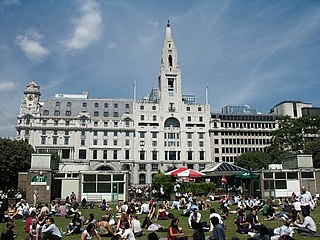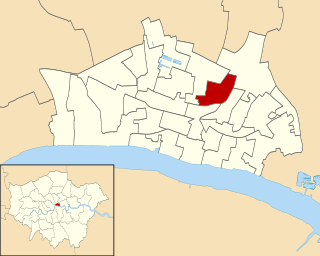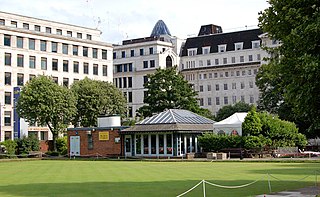
The City of London, widely referred to simply as the City, is a city, ceremonial county and local government district that contains the ancient centre, and constitutes, alongside Canary Wharf, the primary central business district (CBD) of London and one of the leading financial centres of the world. It constituted most of London from its settlement by the Romans in the 1st century AD to the Middle Ages, but the modern area referred to as London has since grown far beyond the City of London boundary. The City is now only a small part of the metropolis of Greater London, though it remains a notable part of central London. Administratively, the City of London is not one of the London boroughs, a status reserved for the other 32 districts. It is also a separate ceremonial county, being an enclave surrounded by Greater London, and is the smallest ceremonial county in England.

Finsbury is a district of Central London, forming the southeastern part of the London Borough of Islington. It borders the City of London.

Shoreditch is a district in London, England. It is within the London Borough of Hackney, alongside neighbouring parts of Tower Hamlets, which are also perceived as part of the area due to historic ecclesiastical links. Shoreditch is considered to be a part of London's East End.

Bethlem Royal Hospital, also known as St. Mary Bethlehem, Bethlehem Hospital and Bedlam, is a psychiatric hospital in Bromley, London. Its famous history has inspired several horror books, films, and TV series, most notably Bedlam, a 1946 film with Boris Karloff.

Bishopsgate was one of the eastern gates in London's former defensive wall. The gate's name is traditionally attributed to Earconwald, who was Bishop of London in the 7th century. It was first built in Roman times and marked the beginning of Ermine Street, the ancient road running from London to York (Eboracum). The gate was rebuilt twice in the 15th and 18th centuries, but was permanently demolished in 1760.
Farringdon is a small district in Central London, the southern part of the London Borough of Islington. The term is used to describe the area around Farringdon station. Historically the district corresponded to southern Clerkenwell and the small parish of St Sepulchre Middlesex.

The London Wall is a defensive wall first built by the Romans around the strategically important port town of Londinium in c. AD 200, as well as the name of a modern street in the City of London, England.
Moorgate was one of the City of London, England's northern gates in its defensive wall, the last to be built. The gate took its name from the Moorfields, an area of marshy land that lay immediately north of the wall.

Moorfields was an open space, partly in the City of London, lying adjacent to – and outside – its northern wall, near the eponymous Moorgate. It was known for its marshy conditions, the result of the defensive wall acting as a dam, impeding the flow of the River Walbrook and its tributaries.
The EC postcode area, also known as the London EC postal area, is a group of postcode districts in central London, England. It includes almost all of the City of London and parts of the London boroughs of Islington, Camden, Hackney, Tower Hamlets and Westminster. The area covered is of very high density development. Deliveries for the EC postcode area are made from Mount Pleasant Mail Centre.

The Walbrook is a subterranean river in London. It gives its name to the Walbrook City ward and to a nearby street. It played an important role in the Roman settlement of Londinium.

Finsbury Pavement is a short length of street in England connecting Moorgate with City Road in the London Borough of Islington. It forms a part of the London Inner Ring Road, and before the introduction of the ring of steel around the City of London it formed a major through-route towards London Bridge and south London.

Finsbury Circus is a park in the Coleman Street Ward of the City of London, England. The 2 acre park is the largest public open space within the City's boundaries.

Broad Street is one of the 25 ancient wards of the City of London.

Coleman Street is one of the 25 ancient wards of the City of London, England, and lies on the City's northern boundary with the London Borough of Islington.

Finsbury Square is a 0.7-hectare (1.7-acre) square in Finsbury in central London which includes a six-rink grass bowling green. It was developed in 1777 on the site of a previous area of green space to the north of the City of London known as Finsbury Fields, in the parish of St Luke's and near Moorfields. It is sited on the east side of City Road, opposite the east side of Bunhill Fields. It is approximately 200m north of Moorgate station, 300m north-west of Liverpool Street station and 400m south of Old Street station. Nearby locations are Finsbury Circus and Finsbury Pavement. Named after it, but several miles away, are Finsbury Park and its eponymous neighbourhood.

The New Churchyard was a municipal and non-parochial burial ground in London. Established in 1569, it was used for burial from 1570 until 1739, by which date approximately 25,000 interments were estimated to have taken place. It was created to accommodate the ever-increasing number of new interments required as London's population expanded during 16th to 18th centuries. It was known as a "churchyard" despite not being associated with a church and, from the mid-17th century, became more commonly known as Bedlam or Bethlem burial ground because its location within the "Bedlam" or "Bethlem" area. The remains of the burial ground are now located under modern Liverpool Street, within the north-east corner of the City of London.
The London Savings Bank was a product of a 1916 merger between the London Provident Institution (1816), the Bloomsbury Savings Bank (1817) and the Lambeth Savings Bank (1818). In 1942 the Finsbury and City of London Savings Bank amalgamated with the London Savings Bank. In 1971, the London Savings Bank became part of the London and South Eastern TSB, which in turn became part of TSB South East.















